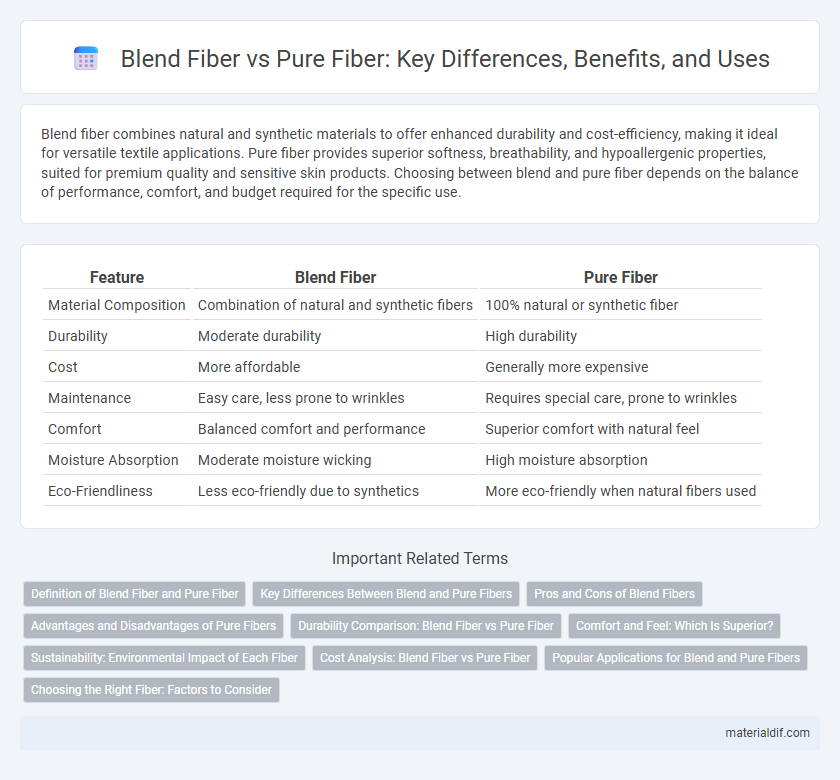Blend fiber combines natural and synthetic materials to offer enhanced durability and cost-efficiency, making it ideal for versatile textile applications. Pure fiber provides superior softness, breathability, and hypoallergenic properties, suited for premium quality and sensitive skin products. Choosing between blend and pure fiber depends on the balance of performance, comfort, and budget required for the specific use.
Table of Comparison
| Feature | Blend Fiber | Pure Fiber |
|---|---|---|
| Material Composition | Combination of natural and synthetic fibers | 100% natural or synthetic fiber |
| Durability | Moderate durability | High durability |
| Cost | More affordable | Generally more expensive |
| Maintenance | Easy care, less prone to wrinkles | Requires special care, prone to wrinkles |
| Comfort | Balanced comfort and performance | Superior comfort with natural feel |
| Moisture Absorption | Moderate moisture wicking | High moisture absorption |
| Eco-Friendliness | Less eco-friendly due to synthetics | More eco-friendly when natural fibers used |
Definition of Blend Fiber and Pure Fiber
Blend fiber consists of two or more different types of fibers combined to create textiles with enhanced properties such as durability, stretch, or moisture-wicking, commonly seen in cotton-polyester blends. Pure fiber refers to textiles made entirely from a single fiber type, like 100% cotton or 100% wool, offering natural characteristics unique to that fiber. The choice between blend fiber and pure fiber depends on desired fabric performance, comfort, and application in clothing or industrial uses.
Key Differences Between Blend and Pure Fibers
Blend fibers combine natural and synthetic materials, offering enhanced durability, flexibility, and cost-effectiveness compared to pure fibers. Pure fibers, made entirely from natural or synthetic sources, provide superior breathability, authenticity, and specific performance characteristics unique to the fiber type. Understanding these differences is crucial for selecting the right fiber based on application needs such as comfort, strength, and maintenance.
Pros and Cons of Blend Fibers
Blend fibers combine natural and synthetic materials, offering enhanced durability, flexibility, and cost-effectiveness compared to pure fibers. They improve moisture-wicking and wrinkle resistance, making them ideal for activewear and everyday use, but may sacrifice some breathability and environmental sustainability found in pure fibers. The trade-offs include less biodegradability and potential skin sensitivity, requiring consideration of specific end-use requirements.
Advantages and Disadvantages of Pure Fibers
Pure fibers, derived from a single fiber source such as cotton, wool, or silk, offer advantages including consistent texture, superior strength, and enhanced durability. They provide excellent breathability and natural moisture-wicking properties, making them ideal for sensitive skin and high-performance textiles. However, pure fibers can lack flexibility, may wrinkle easily, and often require more specialized care compared to blended fibers.
Durability Comparison: Blend Fiber vs Pure Fiber
Blend fiber combines synthetic and natural materials, enhancing durability by increasing resistance to wear, tearing, and environmental factors compared to pure fiber. Pure fiber, such as 100% cotton or wool, offers breathability and comfort but tends to degrade faster under heavy use or exposure to moisture. The durability advantage of blend fibers makes them ideal for high-traffic applications where long-lasting performance is essential.
Comfort and Feel: Which Is Superior?
Blend fiber offers a balanced combination of softness and durability, providing a comfortable feel that resists wrinkles and retains shape better than pure fibers. Pure fiber, such as 100% cotton or wool, delivers superior breathability and natural texture, enhancing comfort for sensitive skin but may require more care to maintain its softness. The choice between blend and pure fiber depends on prioritizing ease of maintenance versus the authentic, luxurious feel of natural materials.
Sustainability: Environmental Impact of Each Fiber
Blend fibers combine natural and synthetic materials, often leading to lower biodegradability and increased microplastic pollution compared to pure fibers. Pure fibers, especially those sourced from sustainably managed natural resources like organic cotton or hemp, typically have a smaller environmental footprint due to their renewable nature and easier recyclability. The sustainability of each fiber largely depends on production methods, lifecycle emissions, and end-of-life disposal practices, with pure fibers generally favored for reducing long-term environmental impact.
Cost Analysis: Blend Fiber vs Pure Fiber
Blend fiber combines natural and synthetic materials, offering a cost-effective alternative to pure fiber by reducing raw material expenses and manufacturing complexity. Pure fiber, consisting entirely of natural fibers, typically incurs higher costs due to resource-intensive cultivation, harvesting, and processing methods. Despite the initial savings with blend fiber, long-term durability and maintenance costs of pure fiber can sometimes offset upfront price differences.
Popular Applications for Blend and Pure Fibers
Blend fibers, combining natural and synthetic materials, are popular in activewear and upholstery due to their enhanced durability, moisture-wicking, and stretch properties. Pure fibers, like 100% cotton or wool, are favored in luxury fashion and home textiles, providing natural breathability and comfort. Industrial applications often use pure fibers for insulation and filtration, where consistent performance is critical.
Choosing the Right Fiber: Factors to Consider
When choosing between blend fiber and pure fiber, consider factors such as durability, cost, and intended use; pure fibers like cotton or wool offer natural feel and breathability, while blend fibers provide enhanced strength and wrinkle resistance. Assessing the environmental impact and care requirements is crucial, as pure fibers tend to be biodegradable but may require more delicate handling compared to synthetic blends. Understanding these factors ensures selection of fiber that best suits performance needs and lifestyle preferences.
Blend Fiber vs Pure Fiber Infographic

 materialdif.com
materialdif.com